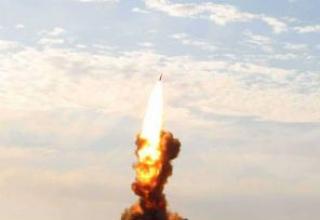The LIM-49A anti-missile Spartan was developed in 1965 and was designed to intercept ballistic missile warheads at high altitudes outside the atmosphere. The contract for the development and production of this missile was divided between Western Electric and McDonnell-Douglas.
The Spartan rocket was a further development of the Nike Zeus-B anti-missile and was originally designated Nike-EX. Unlike the Nike Zeus-B, the Spartan had an extended range, heavier combat unit and better maneuverability.
The Spartan rocket was one of the elements of the Safeguard missile defense project. As part of this project, the interception of warheads at shorter ranges, within the atmosphere was supposed to be carried out with the help of "Sprint" missiles by Martin Orlando.
"Spartan, having a longer range, could also be used against satellites, so in May 1963, its prototype - Nike Zeus -B intercepted an orbiting satellite, and from June 1963 to May 1966 Nike Zeus -B with a nuclear warhead was on combat duty at Kwajalein Atoll for possible interception of Soviet satellites.
Composition:
The Spartan and Nike Zeus-B are almost identical in appearance; the only visible difference is that the diameter of the second stage of the Spartan rocket is the same as that of the first stage, while Nike Zeus-B has each subsequent stage smaller than the previous.
The first stage (see diagram) had four aerodynamic rudders mounted in the same plane with four second stage rudders. The third stage also had four rudders, which provided control in the upper layers of the atmosphere, and were placed at an angle of 45 degrees to the rudders of the 1st and 2nd stages.
The combat unit of the missile is a thermonuclear warhead W-71 5Mt. It was controlled by radio channel.
Improvement of the missile went in the direction of reducing the reaction time of the complex by increasing speed and acceleration on the entire trajectory, increasing range and maneuverability. The increase in firing accuracy, as calculated by American specialists, could have led to a reduction in the warhead power to 1Mt.
The engines are designed by the American company "Thiokol". The first stage is TX-500 engine (thrust 2200kN), the second stage is TX-454, the third stage is TX-239.
The anti-missile was supposed to carry a neutron nuclear warhead. The design of this charge in an explosion at high altitudes was to produce X-beams of high energy. Several possible ways of using these beams for target destruction were assumed. One was the effect of the X rays on the target warhead that would produce secondary X rays inside its hull and cause the electronic circuits of the guidance systems to fail and detonate the warhead. Semiconductor elements such as transistors and diodes are vulnerable to radiation if they do not have heavy protective shielding.
Another possible way was for X-rays to affect the ablative protective coating of the cone. This material absorbed the energy of the X-rays and was heated to such a high temperature that it led to premature ablation of the shielding and combustion of the warhead at entry into the atmosphere.
Characteristics:
| The length of the rocket, m | 16.825 |
| Maximum case diameter, m | 1.07 |
| Wingspan, m | 3.0 |
| Start weight,kg | 13000 |
| Flight Speed, M | 4 -7 |
| Target intercept altitude, km | 250-550 |
| Range,km | 750 |
| BC power,mt | 5.0 |
Testing:
Testing of the missile began in 1968 at Kwajalein Atoll in the Pacific Ocean and was generally successful. Due to the high ground water level at the atoll, the missiles were launched from a mine built in a large embankment.
March 30, 1968 - the first test launch of the rocket, June 4, 1969 - the destruction of the rocket in flight, April 1970 - a series of 11 launches (of which 2 - completely failed, 2 - partially), August 28, 1970 - the first real interception of the warhead LGM-30 "Minuteman" in the 100-mile range. June 11, 1971 - double launch, target intercepted by the first missile, the second eliminated at a given point.
Under the 1972 ABM Treaty between the U.S.S.R. and the U.S.S.R. each side could have two missile defense areas: one for the capital's missile defense and the other for one of the bases of strategic mine type ICBMs. But under the Protocol of 1974, the parties decided to have one BMD area each: the USSR - an area to provide BMD for Moscow, the U.S. - an area for the Grand Forks air base. On October 1, 1975, the U.S. Safeguard missile defense system consisting of 30 Spartan missiles and 70 Sprint missiles was put on combat duty, but later, due to low efficiency and high cost, was decommissioned.
In the early 1980s, the Spartan project returned to the Strategic Defense Initiative (SDI). Spartan was supposed to be used as a carrier of several interceptors with homing optical heads that would provide direct hit against ballistic missile warheads. However, the U.S. did not risk violating the Soviet-American ABM treaty at that time and this project was not destined to come true.
Sources:
- В.В.Телегин"Развитие и совершенствование ракетного стратегического,оперативно-тактического,зенитного оружия и СУ за рубежом",1970г.;
- Смирнова М.В. Проблемы разработки антиснарядов;
- Техническая информация ОНТИ.ЦАГИ 1968 №7-9 с.38-46; Новиков И.В.
- Исследования концепций средств противоракетной обороны за рубежом//
- Техническая информация ОНТИ.ЦАГИ 1986 №3-4 c.1-20.
- http://www.designation-systems.net





